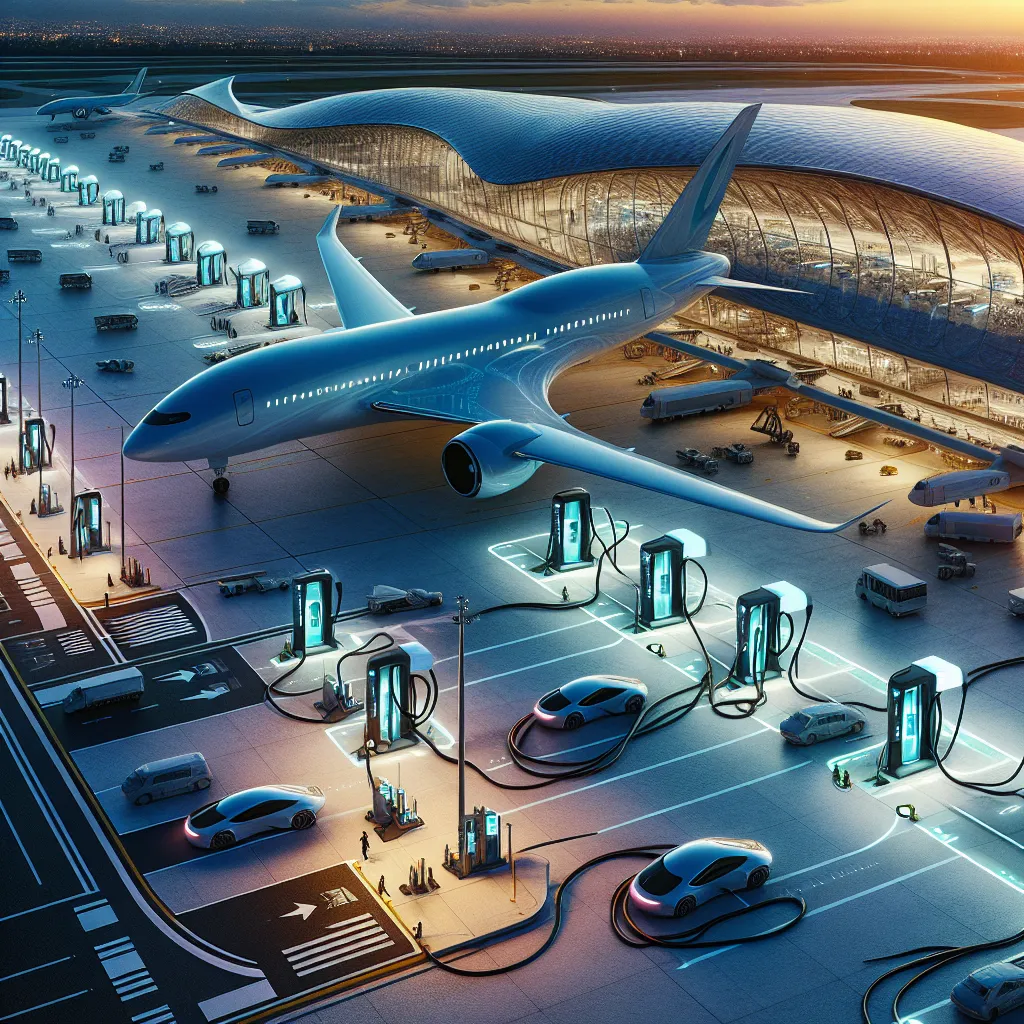Welcome to our IELTS Reading practice session focusing on “The Future of Electric Aviation.” This comprehensive guide will provide you with a full IELTS Reading test, including three passages of increasing difficulty, along with a variety of question types to help you prepare for the real exam. Let’s dive in and explore this exciting topic while honing your reading skills!
Nội dung bài viết
- Introduction
- Passage 1 (Easy Text)
- The Rise of Electric Aircraft
- Questions 1-5
- Questions 6-10
- Passage 2 (Medium Text)
- Overcoming Challenges in Electric Aviation
- Questions 11-15
- Questions 16-20
- Passage 3 (Hard Text)
- The Socioeconomic Implications of Electric Aviation
- Questions 21-26
- Questions 27-30
- Questions 31-35
- Answer Key
- Passage 1
- Passage 2
- Passage 3
- Conclusion
 The future of electric aviation
The future of electric aviation
Introduction
The aviation industry is on the brink of a revolutionary change with the advent of electric aircraft. This IELTS Reading practice test will explore various aspects of electric aviation, its potential impact on the environment, and the challenges and opportunities it presents. As you work through these passages, pay close attention to the vocabulary and concepts related to aviation technology, environmental sustainability, and industry transformation.
Passage 1 (Easy Text)
The Rise of Electric Aircraft
The aviation industry is experiencing a significant shift towards more sustainable practices, with electric aircraft at the forefront of this transformation. These innovative planes, powered by electricity rather than traditional jet fuel, promise to revolutionize air travel by reducing carbon emissions and operating costs.
Electric aircraft come in various forms, from small personal aircraft to larger commercial planes. They utilize advanced battery technology and electric motors to propel themselves through the air. Unlike conventional aircraft that rely on combustion engines, electric planes produce zero direct emissions during flight, making them an environmentally friendly alternative.
The development of electric aircraft has been driven by several factors. First, there is increasing pressure on the aviation industry to reduce its carbon footprint and combat climate change. Second, advancements in battery technology have made electric flight more feasible. Finally, the potential for reduced operating costs has attracted interest from airlines and aircraft manufacturers alike.
While electric aviation is still in its early stages, several companies are making significant strides in this field. Start-ups and established aerospace firms are investing heavily in research and development, with some prototype electric planes already taking to the skies. These early successes have generated excitement about the potential for widespread adoption of electric aircraft in the coming decades.
However, challenges remain. The energy density of batteries is still lower than that of jet fuel, limiting the range and payload capacity of electric aircraft. Additionally, the infrastructure for charging and maintaining electric planes needs to be developed. Despite these hurdles, many experts believe that electric aviation represents the future of air travel, particularly for short-haul flights.
As technology continues to advance, we can expect to see more electric aircraft in our skies, contributing to a cleaner and more sustainable future for aviation.
Questions 1-5
Do the following statements agree with the information given in the passage? Write
TRUE if the statement agrees with the information
FALSE if the statement contradicts the information
NOT GIVEN if there is no information on this
- Electric aircraft produce no direct emissions during flight.
- The aviation industry is under pressure to reduce its environmental impact.
- All major airlines have already ordered electric aircraft for their fleets.
- Battery technology is currently more efficient than jet fuel for long-haul flights.
- Electric aviation is expected to be particularly beneficial for short-distance flights.
Questions 6-10
Complete the sentences below. Choose NO MORE THAN TWO WORDS from the passage for each answer.
- Electric aircraft use ___ and electric motors for propulsion.
- The development of electric planes has been partly driven by advancements in ___ technology.
- Both ___ and established aerospace companies are investing in electric aviation research.
- One of the main challenges for electric aircraft is the lower ___ of batteries compared to jet fuel.
- Experts believe that electric aviation will contribute to a more ___ future for the industry.
Passage 2 (Medium Text)
Overcoming Challenges in Electric Aviation
The path to widespread adoption of electric aircraft is fraught with technical and logistical challenges. However, innovative solutions are emerging to address these obstacles, paving the way for a new era in aviation. This passage explores the hurdles facing electric aviation and the cutting-edge technologies being developed to overcome them.
One of the primary challenges in electric aviation is the limited energy density of batteries. Currently, the best lithium-ion batteries store only about 1/60th of the energy of jet fuel by weight. This limitation significantly restricts the range and payload capacity of electric aircraft. To address this issue, researchers are exploring advanced battery chemistries, such as lithium-sulfur and solid-state batteries, which promise higher energy densities and improved safety profiles.
Another area of focus is the development of hybrid-electric propulsion systems. These systems combine electric motors with conventional combustion engines or fuel cells, offering a bridge technology that can extend range while still reducing emissions. Some designs incorporate distributed electric propulsion, where multiple small electric motors are placed along the wings, improving aerodynamic efficiency and redundancy.
The charging infrastructure for electric aircraft presents another significant challenge. Unlike cars, which can be charged relatively slowly overnight, commercial aircraft require rapid charging to maintain tight flight schedules. Engineers are working on high-power charging systems capable of delivering megawatts of power in short periods. Additionally, the concept of battery swapping is being explored as a potential solution for quick turnarounds.
Thermal management is a critical issue in electric aviation. High-power electric motors and batteries generate significant heat, which must be efficiently dissipated to maintain performance and safety. Advanced cooling systems, including liquid cooling and phase change materials, are being developed to address this challenge.
The certification process for electric aircraft is another hurdle. Aviation authorities must develop new standards and regulations to ensure the safety and reliability of these novel technologies. This process involves extensive testing and validation, which can be time-consuming and costly for manufacturers.
Despite these challenges, the potential benefits of electric aviation are driving continued innovation. Reduced operating costs, lower noise pollution, and decreased environmental impact are powerful incentives for the industry to overcome these obstacles. As technologies mature and regulatory frameworks evolve, we can expect to see electric aircraft playing an increasingly important role in the future of aviation.
The transition to electric aviation also presents opportunities for synergy with other sectors. For example, advancements in electric vehicle technology can be adapted for use in aircraft, while improvements in renewable energy generation and smart grid systems can support the charging infrastructure needed for electric planes.
As the aviation industry works to overcome these challenges, it is clear that the future of flight is likely to be increasingly electric, transforming the way we travel and shaping a more sustainable future for air transportation.
Questions 11-15
Choose the correct letter, A, B, C, or D.
-
What is described as the primary challenge for electric aviation?
A) Regulatory approval
B) Battery energy density
C) Charging infrastructure
D) Thermal management -
Which of the following is NOT mentioned as a potential solution to improve battery performance?
A) Lithium-sulfur batteries
B) Solid-state batteries
C) Nickel-cadmium batteries
D) Hybrid-electric propulsion systems -
What advantage does distributed electric propulsion offer?
A) Increased fuel efficiency
B) Higher flight speeds
C) Improved aerodynamic efficiency
D) Lower manufacturing costs -
Why is rapid charging important for commercial electric aircraft?
A) To reduce electricity costs
B) To maintain flight schedules
C) To improve battery life
D) To comply with regulations -
Which sector is mentioned as having potential synergy with electric aviation?
A) Automotive industry
B) Shipping industry
C) Rail transportation
D) Space exploration
Questions 16-20
Complete the summary below. Choose NO MORE THAN TWO WORDS from the passage for each answer.
Electric aviation faces several challenges, including the need for batteries with higher (16) . Researchers are developing new battery types and (17) propulsion systems to address range limitations. The development of (18) is crucial for quick turnarounds of commercial electric aircraft. (19) is a significant issue that requires advanced cooling systems. Despite these hurdles, the potential for (20) ___ and environmental benefits is driving continued innovation in the field.
Passage 3 (Hard Text)
The Socioeconomic Implications of Electric Aviation
The advent of electric aviation is poised to bring about profound changes not only in the technological landscape but also in the socioeconomic fabric of societies worldwide. This transformative shift in air transportation has the potential to reshape urban planning, alter economic structures, and influence social dynamics in ways that extend far beyond the immediate realm of aviation.
One of the most significant implications of electric aviation is its potential to revolutionize urban air mobility. The development of small, efficient electric aircraft could lead to the proliferation of air taxi services, fundamentally altering the concept of urban transportation. This shift could catalyze the creation of vertiports – dedicated takeoff and landing facilities for electric vertical takeoff and landing (eVTOL) aircraft – in urban centers. Such infrastructure could alleviate ground traffic congestion and potentially reshape urban landscapes, necessitating new approaches to city planning and zoning regulations.
The economic ramifications of electric aviation are multifaceted. On one hand, the transition to electric aircraft could lead to significant job creation in emerging sectors such as battery technology, electric propulsion systems, and advanced materials. Conversely, it may result in job displacement in traditional aviation-related industries, particularly those associated with fossil fuel-based technologies. This shift underscores the need for proactive workforce development strategies and educational initiatives to prepare for the evolving job market.
From an environmental perspective, the widespread adoption of electric aircraft could contribute significantly to reducing the aviation industry’s carbon footprint. However, this environmental benefit must be weighed against the ecological impact of increased battery production and the sourcing of rare earth elements required for electric propulsion systems. Striking a balance between these competing environmental concerns will be crucial for ensuring the sustainable development of electric aviation.
The geopolitical landscape may also be reshaped by the rise of electric aviation. Countries and regions with advanced capabilities in electric vehicle technology and battery production could gain strategic advantages in the global aviation market. This shift could alter existing power dynamics within the aerospace industry and potentially influence international trade relations and diplomatic ties.
Electric aviation has the potential to democratize air travel by reducing operating costs and enabling more frequent flights to smaller, underserved communities. This could lead to increased connectivity and economic opportunities for remote regions, potentially mitigating rural-urban disparities. However, it also raises questions about airspace management and the need for robust regulatory frameworks to ensure safety and equity in access to air transportation.
The noise reduction associated with electric aircraft could have profound implications for quality of life in areas near airports. Reduced noise pollution could lead to changes in real estate values and urban development patterns around airports, potentially transforming these areas into more desirable residential and commercial zones.
The integration of electric aviation into existing transportation networks presents both opportunities and challenges. It could facilitate more seamless intermodal transportation, allowing for better integration with electric ground vehicles and public transit systems. However, this integration would require significant investments in infrastructure and the development of new logistical paradigms.
As electric aviation technology matures, it may also influence social norms and behaviors related to travel. The potential for more frequent, short-distance air travel could alter perceptions of distance and accessibility, potentially impacting patterns of social interaction, business practices, and leisure activities.
The ethical considerations surrounding electric aviation are complex and multifaceted. Issues such as the equitable distribution of benefits, privacy concerns related to increased aerial mobility, and the environmental ethics of battery production and disposal will need to be addressed as the technology becomes more prevalent.
In conclusion, the socioeconomic implications of electric aviation extend far beyond the technological realm, touching on aspects of urban development, economic structures, environmental sustainability, and social dynamics. As this technology continues to evolve, it will be crucial for policymakers, industry leaders, and communities to engage in thoughtful dialogue and strategic planning to harness its potential benefits while mitigating potential negative impacts. The future of electric aviation holds the promise of transformative change, but realizing its full potential will require careful navigation of the complex interplay between technological innovation and societal needs.
Questions 21-26
Complete the table below. Choose NO MORE THAN THREE WORDS from the passage for each answer.
| Aspect | Potential Impact of Electric Aviation |
|---|---|
| Urban Planning | Creation of (21) ___ for eVTOL aircraft |
| Economy | Job creation in (22) ___ sectors |
| Environment | Reduction in aviation’s (23) ___ |
| Geopolitics | Alteration of (24) ___ in aerospace industry |
| Rural Development | Increased (25) ___ for remote regions |
| Quality of Life | (26) ___ near airports due to reduced noise pollution |
Questions 27-30
Choose FOUR letters, A-H. Which FOUR of the following are mentioned in the passage as potential effects of electric aviation?
A) Increased air traffic congestion
B) Changes in social interaction patterns
C) Reduced demand for fossil fuels
D) Higher real estate values near airports
E) Decreased international air travel
F) New challenges in airspace management
G) Improved integration with ground transportation
H) Increased pollution from battery production
Questions 31-35
Do the following statements agree with the claims of the writer in the passage? Write
YES if the statement agrees with the claims of the writer
NO if the statement contradicts the claims of the writer
NOT GIVEN if it is impossible to say what the writer thinks about this
- Electric aviation will completely eliminate the need for traditional airports.
- The transition to electric aircraft will create more jobs than it displaces.
- Electric aviation could help reduce disparities between urban and rural areas.
- The noise reduction from electric aircraft will only affect areas immediately adjacent to airports.
- The ethical implications of electric aviation are straightforward and easily resolved.
Answer Key
Passage 1
- TRUE
- TRUE
- NOT GIVEN
- FALSE
- TRUE
- advanced battery
- battery
- Start-ups
- energy density
- sustainable
Passage 2
- B
- C
- C
- B
- A
- energy density
- hybrid-electric
- charging infrastructure
- Thermal management
- reduced operating costs
Passage 3
- vertiports
- battery technology
- carbon footprint
- power dynamics
- connectivity
- Reduced noise pollution
- B, D, F, G
- YES
- NOT GIVEN
- YES
- NO
- YES
Conclusion
This IELTS Reading practice test on “The Future of Electric Aviation” has covered a wide range of aspects related to this exciting field. From the basic concepts of electric aircraft to the complex socioeconomic implications, these passages have provided a comprehensive overview of the topic.
As you prepare for your IELTS exam, remember to:
- Practice time management to ensure you can complete all questions within the allotted time.
- Pay close attention to keywords and phrases that can help you identify correct answers.
- Develop your skimming and scanning skills to quickly locate relevant information in the passages.
- Expand your vocabulary, particularly in technical and scientific areas related to aviation and environmental topics.
For more IELTS Reading practice, you might be interested in our articles on the future of drone technology in logistics and the impact of electric vehicles on fossil fuel demand. These topics are closely related to electric aviation and can help broaden your understanding of technological advancements in transportation.
Remember, consistent practice and exposure to a variety of topics will help you improve your reading skills and prepare you for success in the IELTS Reading test. Good luck with your studies!


